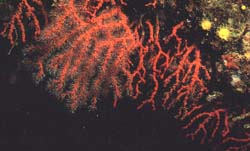Red Coral
(Corallium rubrum)


Red Coral (Corallium rubrum) |
 he red coral lives forming tree-like colonies with irregular shape
branches. It has a calcium skeleton which may reach a lenght of 2 feet, though normally is
well under this size. Those branches are formed by white polips, each one with 8 tiny
tentacles. The branches are covered with a bright red tissue, though sometimes it can be
white or even yellow. The inner skeleton can be found in all shades of red, including
white and black. he red coral lives forming tree-like colonies with irregular shape
branches. It has a calcium skeleton which may reach a lenght of 2 feet, though normally is
well under this size. Those branches are formed by white polips, each one with 8 tiny
tentacles. The branches are covered with a bright red tissue, though sometimes it can be
white or even yellow. The inner skeleton can be found in all shades of red, including
white and black.
This coral can be misidentified with the "false coral" (Parerythropodium
coralloides) which appears encrusting dead gorgonians skeletons, but it can be
identified because of its soft texture and the different polips. Red coral can also be
confused with a briozoans colony called Myriapora truncata, though its color is
bright orange, the branches are regular and flat ended. Once dead its color fades to
white, while the red coral retains its bright red color.
Red corals can be found in the western Mediterranean Sea and in the Adriatic, inside dark
holes and crevices. It can be found also at great depths. In the past it abounded in caves
over 30 feet but it is rare now. It can be easily found from 100 feet down to 300 feet.
Red coral is formed by two types of polips, the ones with tentacles, in charge of feeding,
and other ones, similar to tiny tubes, which are in charge of keeping water flowing
through a pipeline system inside of the colony.
They reproduce in two ways. There is the fecundation of the ovules, then the mothers let
the free swimming larvae go, which then adhere to the rock substrate nearby, starting a
new colony by partition of itself.
As the skeleton is formed by tiny calcium spicules, it has a glassy consistence, very easy
to work with, so it is very appreciated in jewelry, the reason of its disappearance from
surface waters. Coral has been used for ages, and coral ornaments had been found in graves
25.000 years old in Wiesbaden (Germany). It has been found also in the ancient Egyptian
graves.
The price of coral is higher the stronger the branches are and the lighter the color. By
this reason corallers risk their live to get it from depths of about 300 feet and more.
Actually red coral is collected at a rate of about 60 tons a year, but the yield is very
low, the dredges used to capture it retain only 20% of the extracted coral, and only a
small part of it is useful. The rest is vainly lost in the Sea.
© Foto: Helmut
Göthel
|